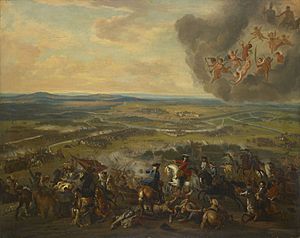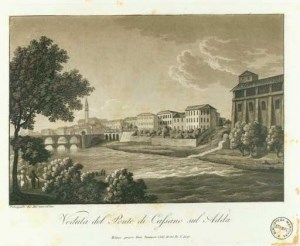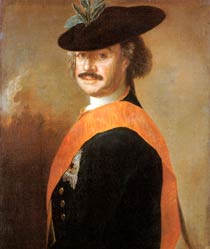Battle of Cassano (1705) facts for kids
Quick facts for kids Battle of Cassano |
|||||||
|---|---|---|---|---|---|---|---|
| Part of the War of the Spanish Succession | |||||||
 The Battle of Cassano, by Jan van Huchtenburgh |
|||||||
|
|||||||
| Belligerents | |||||||
| Commanders and leaders | |||||||
| duc de Vendôme Philippe de Vendôme Armand St Hilaire |
Prince Eugene Leopold of Anhalt-Dessau |
||||||
| Strength | |||||||
| 22,000 24,000 |
20,000 24,000 |
||||||
| Casualties and losses | |||||||
| 5,000 killed or wounded 2,728 killed or wounded 3,000 killed or wounded |
6,050 killed, wounded or captured 4,500 killed, wounded or captured |
||||||
The Battle of Cassano happened on August 16, 1705. It was part of the War of the Spanish Succession. The battle took place near Cassano d'Adda in Lombardy, Italy.
A French army of about 22,000 soldiers fought against an Imperial army of 24,000. The French were led by the duc de Vendôme. The Imperial forces were commanded by Prince Eugene of Savoy.
Before the battle, Victor Amadeus II, ruler of Savoy, had joined the side against France. By 1705, the French had taken most of Savoy. Only its capital, Turin, was still free. Prince Eugene wanted to help Turin. He tried to cross the Adda River at Cassano. This would let him threaten Milan.
The French were surprised, but they managed to hold the bridge. The fighting lasted for many hours. Both sides lost many soldiers. The battle is often seen as not having a clear winner. Vendôme stopped Prince Eugene from crossing the Adda. But Prince Eugene did manage to delay the attack on Turin until 1706.
Later, Vendôme and his troops were called back to France. This happened after the Battle of Ramillies in May 1706. This allowed the Imperial army to break the Siege of Turin in September. The fighting in Northern Italy ended in March 1707.
Why the Battle Happened
The War of the Spanish Succession started in 1700. It began when Charles II of Spain, the king of Spain, died without children. He chose Philip of Anjou, the grandson of Louis XIV of France, to be his heir. Philip became the ruler of the huge Spanish Empire. This empire included Spain, parts of the Netherlands, large areas of Italy, and much of the Americas.
In 1701, arguments over land and trade rights led to war. It was between France and Spain (led by the House of Bourbon) and the Grand Alliance. The Grand Alliance supported Charles, the younger son of Leopold I, Holy Roman Emperor.
The war in Northern Italy was about the Spanish-controlled areas of Milan and Mantua. Leopold I thought these areas were important for protecting Austria. In 1701, French troops took over Milan and Mantua. They were allied with Victor Amadeus II of Savoy. His daughter even married Philip V.
But in 1703, Victor Amadeus changed sides. He joined the Grand Alliance. French forces then captured Savoyard lands north of the Alps. By May 1705, Victor Amadeus only controlled Nice, his capital Turin, and parts of Southern Piedmont.
Even though they were allies, Leopold didn't fully trust Victor Amadeus. Victor Amadeus really wanted to control Milan. Leopold was also busy with a rebellion in Hungary. But with Savoy almost defeated, he sent his best general, Prince Eugene, to Italy. He also sent soldiers and money. This continued after Leopold's death in May, under Emperor Joseph.
These Imperial troops were joined by 8,000 soldiers from Prussia. These Prussian soldiers were led by Leopold of Anhalt-Dessau. England and the Dutch Republic paid for them.
At the start of 1705, French troops in Lombardy were along the Oglio river. They were led by Philippe de Vendôme, the younger brother of the duc de Vendôme. The Imperial army quickly reached Brescia. This forced the French to leave their positions and move back to the Adda River.
In July, Vendôme went to help his brother. He left his deputy, Louis d'Aubusson de La Feuillade, to finish capturing Nice. As he moved, Vendôme captured Savoyard forts at Crescentino and Chivasso. To take pressure off Turin, Prince Eugene marched along the left bank of the Adda. This allowed him to threaten Milan.
Philippe and 10,000 men blocked the closest crossing point at Cassano d'Adda. Vendôme led a mobile group of soldiers along the right bank. They tracked the Imperial army on the left bank.
When the Imperial army reached Iveza, they built a temporary bridge. They used artillery fire to cover it. Vendôme got ready to defend the crossing. But this was a trick. After a small attempt to cross, Prince Eugene burned the bridge. He then headed towards Mantua. Then he turned back quickly. He hoped to surprise the French group at Cassano before they could get more help. On August 14, he reached Romanengo, about 40 kilometers away.
The Battle Begins
The Adda River was deep and fast-flowing. There were only a few places to cross, especially for large armies. The town of Cassano was on the right bank. It had a stone bridge protected by a small fort. The area also had many small streams and canals. The most important was the Retorto, an irrigation canal. It ran next to the Adda. Another bridge connected the Retorto to the left bank. This bridge also had a strong defense point.
Vendôme thought Prince Eugene was going to Mantua. So he told his brother Philippe to leave Cassano. He ordered him to take positions at Rivolta d'Adda. This village was about 10 kilometers away on the left bank of the Adda. Some people think Vendôme's decision was based on false information. This information came from a Spanish officer who was secretly an Austrian spy.
Imperial troops had marched all night from Romanengo. They were already close to the crossing point. A French cavalry patrol spotted them early the next morning. Vendôme realized what was happening. He quickly rode to Cassano with about 2,000 cavalry. He ordered the rest of his army to follow as fast as possible.
When Vendôme arrived, he found Philippe's troops moving. They were in a very dangerous spot. Most of their force was stuck between the Retorto canal and the Adda. Their transport wagons blocked the main bridge. Vendôme ordered the baggage thrown into the river. He formed a line of soldiers. It ran from the Retorto on the left. His center was around the main bridge. His far right rested on the road to Rivolta d'Adda. His brother Philippe was there with four groups of soldiers. Armand St Hilaire, the French artillery commander, placed his cannons inside the town. This allowed him to fire directly at the bridge.
Around 2:00 PM, Imperial grenadiers attacked near the Retorto. At first, they captured the bridge. But St Hilaire's cannons and a French counter-attack pushed them back. Vendôme sent four regiments from the Irish Brigade to help his left side. After tough fighting, the Imperialists captured the sluice gates. They closed them, which lowered the water level in the canal. This made it shallow enough for soldiers to walk across.
Prince Eugene ordered Leopold and his Prussians into the canal. They were to attack the French left side. They managed to reach the other bank. But they lost many soldiers doing so. The battle went back and forth across the river. During the fight, Vendôme's horse was killed under him. Prince Eugene was wounded twice and had to leave the battlefield. The fighting lasted for three to five hours. It ended because both sides were completely exhausted. The opposing forces ended up back in their original positions.
What Happened Next
Almost 25% of the soldiers involved were hurt or killed. Vendôme lost about 5,000 soldiers killed or wounded out of 22,000. His opponents lost over 4,500 soldiers killed, wounded, or captured from 24,000. Some historians say French losses were 2,728 killed or wounded. Imperial losses were around 6,000, including nearly 2,000 taken prisoner. A French officer, the Chevalier Folard, was badly wounded in the battle. He reported similar numbers: 3,000 French and 5,000 Imperial casualties. He also thought Vendôme might have won if he had called on the troops at Rivolta d'Adda.
Prince Eugene said Cassano was a victory for him. This is because he achieved his goal of delaying the Siege of Turin by almost a year. However, historian John A. Lynn calls it a 'minor French tactical victory'. But he agrees it was mostly inconclusive. The two armies watched each other for the next few weeks. Prince Eugene quickly got better from his injuries. In early October, he started building barracks at Treviglio. This made it seem like he planned to stay there for the winter. Vendôme went back to Southern Piedmont to meet with La Feuillade. But it was already October. They decided it was too late in the year to attack Turin.
Still, Victor Amadeus's situation was risky. In December, Nice finally surrendered. His lands north of the Alps were held by France until the war ended.
A defeat at Ramillies in May 1706 forced Louis XIV to call Vendôme back from Italy. This left the less experienced La Feuillade in charge. On August 15, Prince Eugene began his march towards Turin. He reached it on the 29th. His marches were seen as very skillful. They were compared to Marlborough's famous march to the Danube in 1704. After the siege was lifted in September, the remaining French forces left Italy. Fighting in Northern Italy ended with the March 1707 Convention of Milan.
Images for kids








